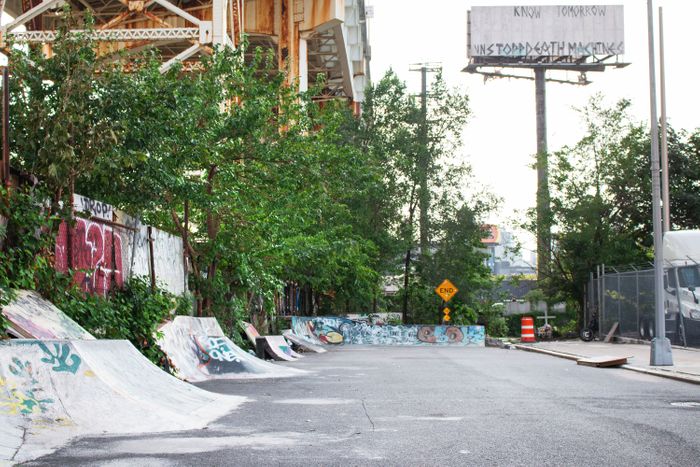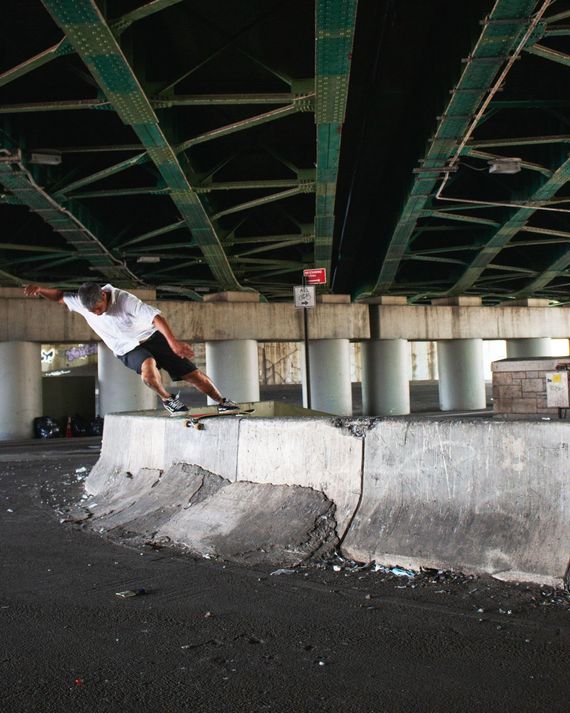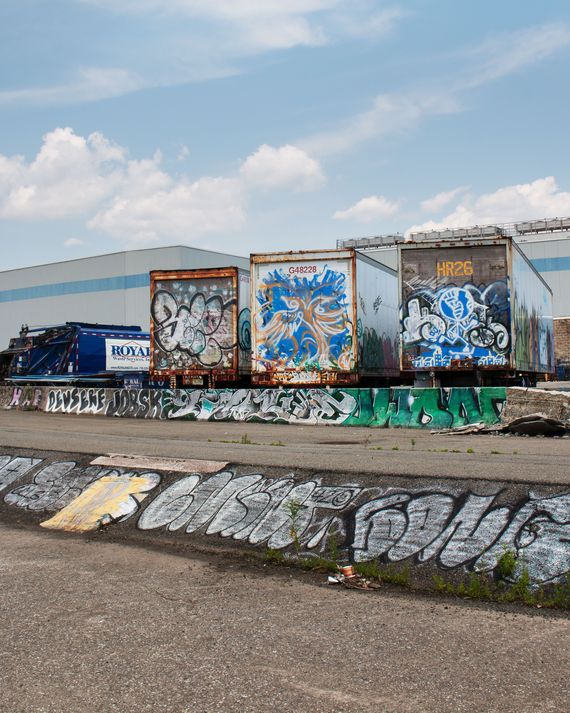The Renegade Skate-Ramp Builders of New York
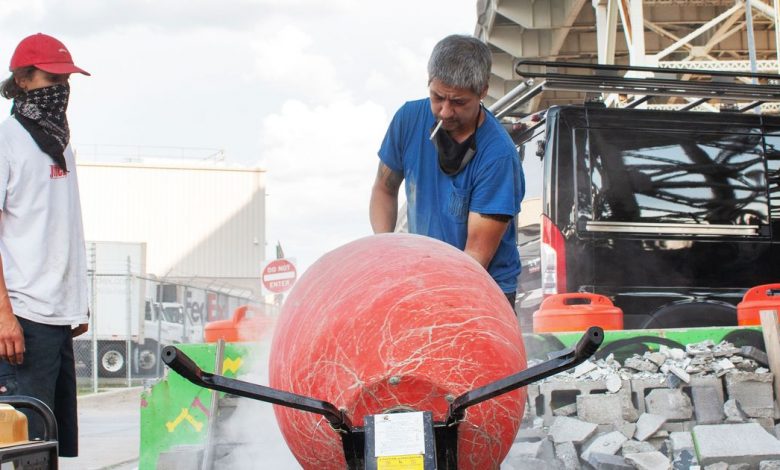

Pat Smith mixes concrete for a quarter pipe at Mosquito Beach as Skateboarder Max Lockhart watches.
Photo: Daniel Karel
On a balmy July evening, Pat Smith, a professional carpenter and owner of CODA Skateboards, was loading his jet black Ram ProMaster van down the aisle of a Greenpoint fabrication shop. Inside the van he had hoisted about eight bags of dusty concrete, a stack of dirty buckets, two crusty shovels, a generator and a portable cement mixer. Smith, 50, was on his way to work on a public secret of the city’s skate scene: an elaborate and unauthorized DIY skate spot hidden under the rusty pillars of the Long Island Expressway. Due to its proximity to a foul stretch of Newton Creek, the place became known as Mosquito Beach.
In terms of scale and longevity, Mosquito Beach is an outlier among the city’s DIY spots, which range from concrete cob spread out over rough obstacles to fully constructed benches and curbs planted overnight in the cityscape. , a vast circuit of ridable spaces existing in tandem with the 37 sanctioned skate parks of New York City. Mosquito Beach is rare among them, a swampy hideaway with an abundance of sloping shorelines and quarter-pipe ramps.
While skateboarders typically attempt these DIY projects in relatively sparsely populated areas of the city, they are – by and large – illegal, especially when built on public property without a permit. This means that skaters can spend a lot of time and resources building a spot only to have their job completely demolished in a day.
“I probably built at least 30 locations that were gone the next morning,” said Jerry Mraz, one of the city’s most prolific builders over the past fifteen years. “A lot of others only lasted a week, and some actually lasted years.”
So what is it that drives them to do it? “People want to leave their mark,” said Steve Rodriguez, founder of famous New York skateboarding company 5boro. “They want to contribute to the scene, they want to skate something exactly the way they want it, they want to offer another option. It’s not just one thing. Smith, a longtime skateboarder and former pro, says that’s the culture’s DIY philosophy. “You want to skate something and you fill the void. “
Mosquito Beach is a DIY spot filled with ramps built by Pat Smith and a rotating cast of skaters. The place is hidden under the Long Island Expressway.
Photo: Daniel Karel
He and a rotating team of other skateboarders have steadily built Mosquito Beach for several years, overwhelming the expected lifespan of a DIY spot. “It’s unbelievable,” said Rodriguez, who also advises the city on sanctioned skatepark designs. “I think one of the main [DOT] guys are nice to skateboarders so i think he’s just slow to deal with that which is great. I guess he was skating a long time ago.
To some, it may not seem like a stretch to compare the efforts of DIY builders to those of graffiti artists – their subcultures are historically intertwined, and they both work, largely under the cover of night, on projects. illegal. But Smith argues that a DIY skate spot achieves something that a graffiti artist’s tag doesn’t – it creates a space that keeps growing and evolving. However, there is one goal that do-it-yourselfers and graffiti artists share: longevity. And that, Mraz explained, depends on location and luck.
“Don’t build on private property, and if it’s private property, it should be something that is far away,” he said. “If it is public property, just put it away, in a place where concerned citizens will not give you a hard time. But to really understand this sometimes the only thing you can do is test it by putting something in there. “
Pat Smith performing rock ‘n’ roll backside at “Pigeon Coop,” a DIY quarterpipe in Maspeth, Queens that Smith estimates to be at least 10 years old.
Photo: Daniel Karel
When Smith and his friends started working on Mosquito Beach – it was pointed out to the spot by a colleague – they seemed to have found the right combination of factors. It was a dead end littered with trash, far from any residential building. So they built a mid-sized quarter-pipe ramp that adjoined an overgrown patch of land dividing the street from the stream. When after a while the ramp hadn’t been ripped off, they started adding more obstacles.
“You put on a little raise and wait, then you do a little bit more and wait,” Smith said. “And then you expect a little more money, more energy, more ideas.”
Smith, a self-described army brat, started building ramps soon after he started skating, at the age of 8. The impulse arose out of necessity. There was nothing exciting about riding near his home, so he and his friends built their own obstacles. He “borrowed” plywood from local construction sites and reference plans found in Thrasher Magazine to turn plywood into ramps.
He moved to New York City in 1997 to work in web design and fell out with a group of skateboarders that included Andy Kessler, a godfather-like figure of the city’s skate scene. Kessler – who died in 2009 – was responsible for what Rodriguez called “the city’s first DIY,” a location in Riverside Park on 109th Street, which Kessler successfully lobbied for the official skate park in 2005. Smith, like many skateboarders, considers Kessler an idol and has spent several years helping him build sanctioned parks throughout town.
The mesh with the city’s skate royalty also gave Smith an overview of local DIY builds. Among them, one of the most memorable was on North 8th Street in Greenpoint, just off the East River. Rodriguez helped build the spot’s quarterpipe and even took his wife there on their first date. “It was the strangest and most impressive mixed-use public space. There would be fathers who would teach their children to ride a bicycle, there would be guys who would take drugs, there were in fact marching bands rehearsing, ”he said. As to how it happened, he said, “There was this guy named Dean. Rumor has it that he won the lottery and paid for the tinkering with those winnings.

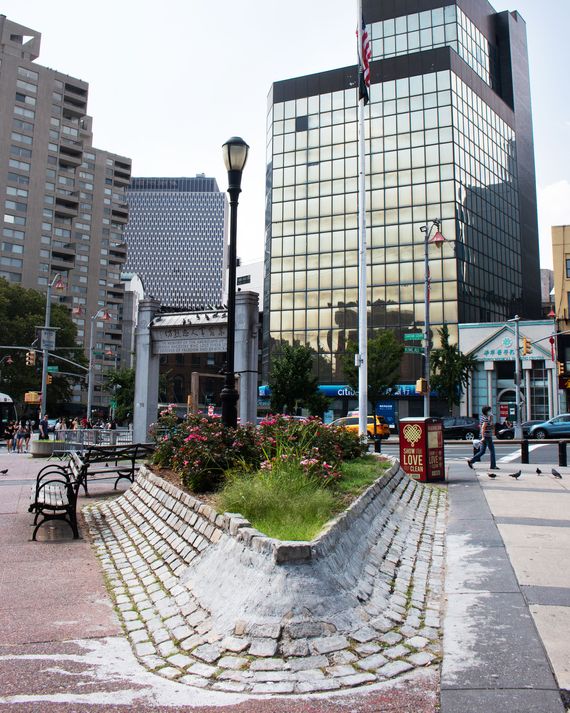
From left to right : A quarter-pipe built against a pillar under the Brooklyn-Queens Expressway. Photo: Daniel KarelConcrete covered the banks of Chinatown, Manhattan. Photo: Daniel Karel
From above: A quarter-pipe built against a pillar under the Brooklyn-Queens Expressway. Photo: Daniel KarelConcrete spread over the banks of Chinatow …
From above: A quarter-pipe built against a pillar under the Brooklyn-Queens Expressway. Photo: Daniel KarelConcrete covered the banks of Chinatown, Manhattan. Photo: Daniel Karel
Another local DIY landmark can be found under the Brooklyn-Queens Freeway. Mraz built most of his worn out obstacles, often on his own, between 2005 and 2010, and much of it is still there. “At one point I had six, maybe seven ledges there, and a bunch of various other dinky quarter pipes,” he said. “Most of the stuff that I thought was cool has been ripped off for a long time, but there are a few things left.”
Other spots, like a pair of curbs set on an embankment near Green-Wood Cemetery, a series of smoothed banks in Chinatown, and obstacles built near a Restaurant Depot in Brooklyn have also joined the pantheon of memorable local projects. . But the scope of Smith-led DIY under the Long Island Expressway appears to be of a whole different caliber.
Near the entrance to Mosquito Beach, Smith parked his van next to a pair of Jersey gates placed by the city in May. They were installed following a fatal car crash in which a driver, with two passengers in tow, drove through the dead end around 5 a.m. The car missed all the DIY obstacles before hitting a tree and then into the creek. The three passengers later died. Tragedy seemed to foreshadow the end of the spot, but, several months later, the only changes included new barriers and a lone lamppost. Most of the skaters stayed away for a while; it was the first time Smith had returned since the accident.
With the help of Nick Boso and Max Lockhart, two skaters in their twenties, Smith unloaded the van, turned on the concrete mixer, and began work on a quarter pipe that would rise over the new barriers. They worked in a relaxed location, a benefit of the remote location. It was the first time Lockhart had built with Boso and Smith (“They’re the best guys to learn,” he said), and he took turns with Smith to draw buckets of water from the creek. neighbor. While they waited for the concrete to take on the consistency of thick oatmeal, Smith walked around collecting trash. Compared to the surrounding street, Mosquito Beach was tidy. One of Smith’s friends had even trimmed the hedges over the obstacles.
“Cosmetic work is part of the process,” he said, a cigarette hanging from his lips. “Picking up bags full of dumped garbage filled with maggots is also part of it. It’s not always glamorous.
When the generator ran out of gas, they mixed the remaining cement with shovels. Soon their hands and clothes were dusty gray. At around 8 p.m., as darkness set in on the street, they threw the last concrete on the quarter pipe, another draft of the final design, and decided to finish it off.
Smith knows that what happens to Mosquito Beach is probably out of his hands. But that does not slow down his desire to continue building these spaces. Leaning against the partially completed quarterpipe, Smith watched the day’s progress with a smile.
“This shit is addictive,” he said.
A DIY spot built near a Restaurant Depot store in Brooklyn.
Photo: Daniel Karel

